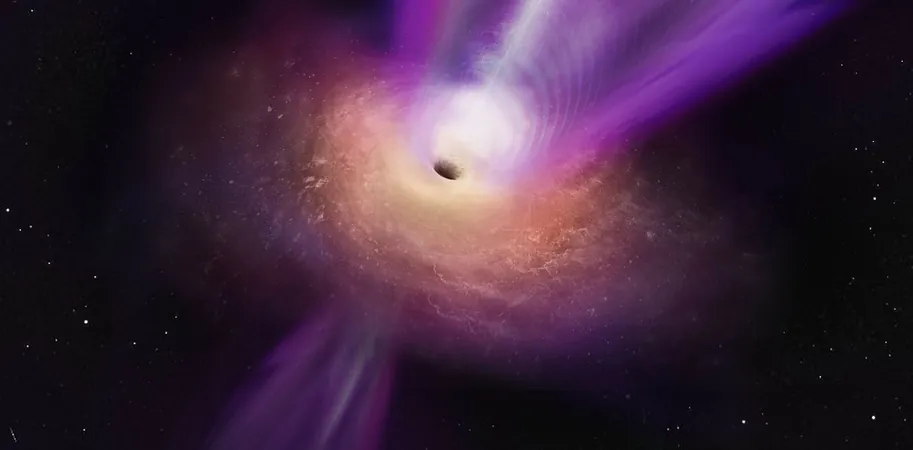
Unveiling the Cosmic Clues: How Black Holes Could Point Us to Habitable Worlds
2025-03-31
Author: Ming
In a remarkable twist of cosmic fate, black holes—some of the most powerful entities in the universe—may hold the keys to identifying potential homes for extraterrestrial life. One fascinating case involves radio quasars, which are spinning black holes expelling high-energy particles at astonishing speeds. While getting too close to one of these black holes could result in a fiery demise due to their immense gravitational pull and heat, studying them offers a unique insight into the conditions favorable for life beyond Earth.
Formation and Structure of Black Holes
Black holes are enormous objects formed from the remnants of massive stars after they have exhausted their nuclear fuel. They use their gravitational force to draw in surrounding matter, which typically forms a hot, glowing structure known as an accretion disk. This disk contains hot, electrically charged gas, producing an incredible amount of energy that can affect the entire galaxy.
The Energy Generation of Black Holes
What’s fascinating is how black holes generate energy through "jets" of particles. As they revolve, they can harness and twist nearby magnetic fields, releasing energy in a jet-like spray, akin to how a twisted rubber band snaps back when released. The nature of this energy output can either promote or inhibit star formation within the galaxy, significantly impacting the potential for habitable planets.
The Role of Black Hole Rotation
One intriguing aspect of black holes is their rotation. Some black holes spin in the opposite direction of their accretion disks—a phenomenon called counterrotation. Research has shown that this counterrotation is a crucial factor in the behavior of the universe's most powerful black holes, particularly radio quasars. These quasars can unleash exceptionally energetic jets which stimulate nearby gas molecules, facilitating star formation. However, there’s a catch: when these quasars transition to a state called corotation, the angle of their jets shifts, heating the surrounding gas and creating harsh conditions that are detrimental to the formation of life-supporting planets.
The Implications for Habitable Worlds
The implications of these findings are immense. For the universe to be brimming with viable worlds where life could flourish, planets must develop in low-density regions devoid of the aggressive cosmic rays emitted by these tilted jets. By eliminating the harsh environments where life is unlikely to thrive, astronomers can focus their searches on galaxies that exhibit conditions more conducive to sustaining living organisms.
Predicting Habitable Environments
In 2022, researchers developed sophisticated models to predict which astrological environments can promote the creation of habitable planets free from harmful X-ray emissions. Such planets are expected to be more common in regions where galaxies amalgamated approximately 11 billion years ago. In these low-density areas, the absence of a highly energetic, tilted jet makes them prime candidates in the quest for extraterrestrial life.
Conclusion
As we continue to explore these cosmic giants, the quest to understand black holes not only unpuzzles fundamental astrophysical principles but also brings us closer to answering one of humanity's most profound questions: Are we alone in the universe? With each discovery, the possibilities expand, urging researchers to look deeper into the cosmos and unravel its mysteries. The next generation of telescopes, equipped to detect and analyze the structure and rotational dynamics of black holes, will aid significantly in this pursuit. So keep your eyes on the stars—you never know what secrets they might reveal about our place in the universe!



 Brasil (PT)
Brasil (PT)
 Canada (EN)
Canada (EN)
 Chile (ES)
Chile (ES)
 Česko (CS)
Česko (CS)
 대한민국 (KO)
대한민국 (KO)
 España (ES)
España (ES)
 France (FR)
France (FR)
 Hong Kong (EN)
Hong Kong (EN)
 Italia (IT)
Italia (IT)
 日本 (JA)
日本 (JA)
 Magyarország (HU)
Magyarország (HU)
 Norge (NO)
Norge (NO)
 Polska (PL)
Polska (PL)
 Schweiz (DE)
Schweiz (DE)
 Singapore (EN)
Singapore (EN)
 Sverige (SV)
Sverige (SV)
 Suomi (FI)
Suomi (FI)
 Türkiye (TR)
Türkiye (TR)
 الإمارات العربية المتحدة (AR)
الإمارات العربية المتحدة (AR)